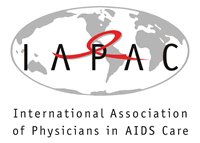IAPAC Guidelines Offer Recommendations to Optimize Entry into and Retention in HIV Care, and Treatment Adherence
New Guidelines e-Published Today by Annals of Internal Medicine
WASHINGTON, March 5, 2012 - The International Association of Physicians in AIDS Care (IAPAC) today announced the publication of a new set of evidence-based guidelines meant to
optimize entry into and retention in HIV care and adherence to HIV treatment. The "Guidelines for
Improving Entry into and Retention in Care and Antiretroviral Adherence for Persons with HIV"
were developed by an expert IAPAC Panel and e-published today by the Annals of Internal Medicine.
The guidelines include recommendations in several key areas, including: entry into and
retention in care; monitoring adherence to HIV care and antiretroviral therapy (ART); interventions
to improve ART adherence including those involving choice of ART regimens; adherence tools for
patients; education and counseling; and health system and service delivery interventions.
The needs of special populations (such as pregnant women, individuals with mental health
and substance use disorders, homeless and marginally housed individuals, incarcerated
individuals, and children and adolescents) are also addressed in the guidelines,
as are recommendations for future research in these areas.
"Over the last 15 years, we have made astounding progress in HIV treatment, resulting
in longer and healthier lives for people living with HIV. Yet many people are unable to optimally
benefit from these advances because of delayed diagnosis and multiple challenges to entering and
staying in medical care," said Melanie A. Thompson, MD, co-chair of the IAPAC Panel. "Once
receiving potent treatment for HIV, many struggle to take their drugs consistently.
Unfortunately, missed doses and drug holidays lead to resistant virus and, often,
to treatment failure. Ultimately, both individual and public health depend on
helping patients to successfully negotiate all of the steps of this treatment cascade."
According to the US Centers for Disease Control and Prevention (CDC), only 69 percent
of HIV-positive persons in the United States enter HIV care, 59 percent are retained in care, and
only 28 percent of Americans living with HIV have an undetectable viral load.(1) A recent African
study found that more than two-thirds of HIV-infected individuals were lost from care if they
were not yet eligible for drug treatment.(2)
In addition, a review of 84 observational studies - or 33,199 adults on ART - revealed
that only 62 percent achieved adherence of at least 90 percent of prescribed ART doses.(3) Adherence
to ART has been shown to be an important predictor of achieving adequate suppression of HIV
replication, which is required to minimize resistance to HIV treatments, slow disease
progression, delay AIDS-related death, and decrease the transmission of HIV to others.
"These guidelines are the foundation of an evolving blueprint that practitioners
and health systems can use as a resource to improve entry into and retention in HIV care as well
as adherence to HIV treatments," said Thompson, who is also Principal Investigator of the AIDS
Research Consortium of Atlanta. The Panel co-chair is Jean B. Nachega, MD, PhD, of Johns
Hopkins University/Stellenbosch University, Baltimore, MD, USA, and Cape Town, South
Africa, respectively.
"IAPAC is proud of the work advanced by our Panel in developing these pioneering
guidelines, which we hope will help strengthen the three pillars of HIV treatment
success - entry into and retention in care, as well as ART adherence," said
Jose M. Zuniga, PhD, MPH, IAPAC's President. "We have known for some time
that much more attention is required to optimize the way in which
HIV-positive patients are linked to and retained on HIV treatment
so that they derive the full benefit of existing care, treatment, and
support. These guidelines are an important step in that direction."
Zuniga further identified some immediate steps IAPAC is taking to implement the
guidelines' recommendations. In the next several months, IAPAC will launch a multidisciplinary
continuing education-accredited online activity to educate physicians, nurses, pharmacists,
and psychologists about the guidelines' recommendations. Peer educator and patient-oriented
activities to increase health and HIV literacy, and to facilitate guidelines-recommended
behavioral interventions are also planned.
Guidelines development was jointly sponsored by IAPAC and the US National Institutes
of Health's Office of AIDS Research.
The e-published guidelines will be available at www.annals.org . A date for print
publication of the guidelines in the Annals of Internal Medicine is pending.
(1) Centers for Disease Control and Prevention. Vital signs: HIV prevention through
care and treatment - United States. MMWR. 2011;60:1618-1623.
(2) Rosen S, Fox MP. Retention in HIV care between testing and treatment in
sub-Saharan Africa: A systematic review. PLoS Medicine. 2011;8(7):e1001056.
(3) Ortego C, Huedo-Medina TB, Llorca J, et al. Adherence to highly active
antiretroviral therapy (HAART): A meta-analysis. AIDS Behav. 2011;15(7):1381-1396.
###

The International Association of
Physicians in AIDS Care (IAPAC)
The International Association of Physicians in AIDS Care (IAPAC) represents more than 17,000 clinicians
in over 100 countries, and advances education, technical assistance, and global health initiatives in
43 countries. Among its initiatives in sub-Saharan Africa are several that are meant to expand the
health workforce's capacity to deliver integrated health services, and to strengthen health
systems so that they may more efficiently utilize their existing health workforces. More
information about IAPAC is available at www.iapac.org. Visit www.iapac.org for more information.
Reproduced with permission -
"International Association of Physicians in AIDS Care (IAPAC)"
International Association of Physicians in AIDS Care (IAPAC)